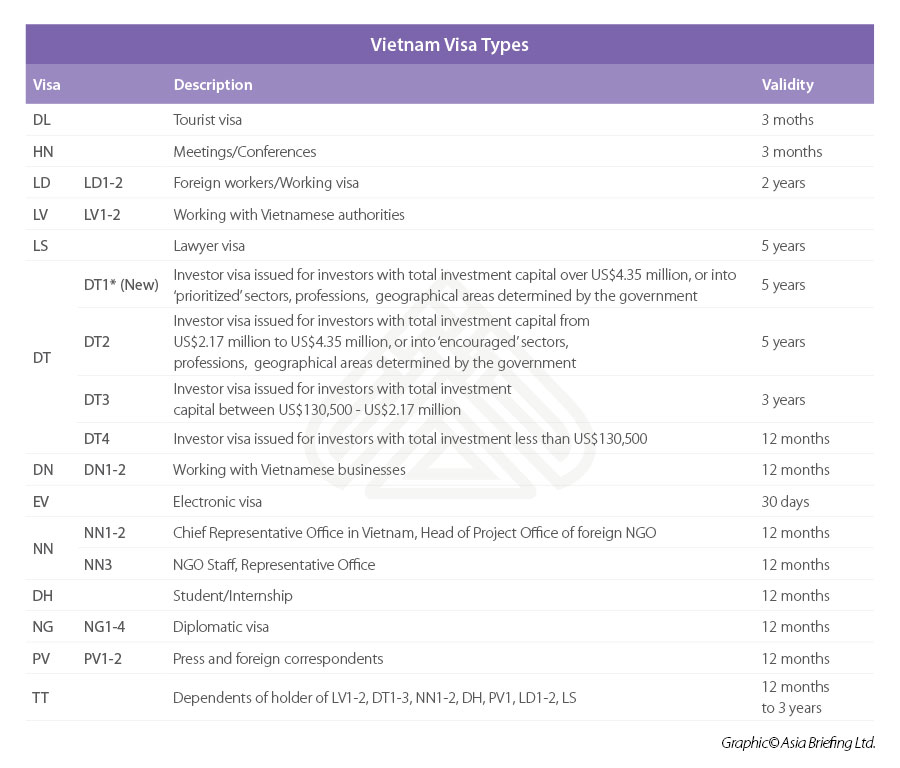Vietnam’s Visas and Work Permit Procedures

Vietnam amended the Law on Entry, Exit, Transit, and Residence of Foreigners in Vietnam (the Immigration Law) which came into force on July 10, 2020.
While the law came into effect in July, Vietnam has barred the entry of foreigners and suspended regular commercials flights since March 25 due to COVID-19. However, Vietnam has allowed the entry of diplomats, foreign experts, business managers, investors, and high-skilled workers. Nevertheless, flights into Vietnam are extremely limited at this time.
Vietnam’s visa and work permit procedures can be confusing for first-time visitors. Vietnam Briefing explains the steps and what foreigners should pay attention to when planning a long-term visit.
The number of foreign skilled workers coming to Vietnam has steadily increased in recent years, surging to over 80,000 at the end of 2018. Most foreign workers that come to Vietnam are employees of foreign contractors, working for, or establishing, foreign direct investment (FDI) projects, coming from over 100 countries.
A Vietnamese entity is permitted to recruit foreign workers in order to work as managers, executive directors, and experts where local hires are not yet able to meet production and business requirements. Unlike in certain other Asian countries, Vietnamese representative offices are also able to hire staff directly.
To demonstrate the necessity of a foreign employee, 30 days prior to recruiting the foreign employee, the entity must publicly announce recruitment for this position to Vietnamese job seekers in a Vietnamese newspaper or online portal.
Evidence of this announcement must be presented in the application for a work permit for a foreign employee. The other option is to recruit foreigners through a government-owned employment service center.
When hiring foreign staff in Vietnam, there are a number of procedures and legal frameworks that must be understood.
Types of visas
In order to enter Vietnam, a foreigner needs a visa issued by the Vietnamese Embassy or Consulate. A Vietnamese visa can be granted while in a third country or from within Vietnam. Citizens of the following countries can receive a free entry visa to Vietnam for the duration listed below:
- ASEAN countries: from 14 to 30 days;
- Chile: 90 days; and
- Belarus, Denmark, Finland, France, Germany, Italy, Japan, Norway, Russia, South Korea, Spain, Sweden, and the UK (British citizens only): 15 days (the gap of at least 30 days in between two visa-free entries has been removed as per the new immigration law.)
In addition, Vietnam also updated the processes and procedures for the e-visa system, allowing a single-entry visit with a duration of up to 30 days, for 81 nationalities. As per the new Immigration Law, the prescribed processing time for e-visa is three working days after completing registration and fee payment.
However, to work in Vietnam and remain for an extended period, foreigners need to apply for a longer-term three-month single or multiple entry visas.
Relevant visa types include:
A new visa type (DT1) is added for foreign investors with contributed capital over VND 1 billion (or US$4.35 million). With a DT1 visa, investors can apply for a temporary residence card with a duration of up to 10 years.
Visa type conversion
The new Immigration Law also allows the conversion of visa types for another purpose without having to leave Vietnam as required by the old regulation. The following cases are eligible for visa type change:
- Investors and representative of a foreign organization investing in Vietnam;
- Dependents of Vietnamese citizens; and
- Being invited or guaranteed by agencies or organizations, and having a work permit or work permit exemption certificate.
A new visa will be granted following a converting visa application.
Additional case for visa exemption
The new Immigration Law adds to the list one more case of visa exemption for foreigners entering border-gate or coastal economic zones, under the decision of the government. The coastal zone needs to meet the following conditions:
- Having an international airport and a separate space (definite boundaries and separated from the mainland);
- In accordance with the socio-economic development policy; and
- Does not pose a threat to national security, defense, social order, and safety.
This type of visa exemption is valid for 30 days.
Work permit procedures and requirements
A work permit is required when working in Vietnam for more than three months. This should ideally be applied 15 days by the employer with the provincial Ministry of Labor, Invalids and Social Affairs (MoLISA) before the foreign worker commences their employment. Work permit processing times take up to 10 business days. A work permit cannot be applied directly by the workers/foreigners, but with the assistance of their employers from Vietnam.
A work permit is required to apply for a temporary residence card or a working visa in Vietnam. Under the new Labor Code 2019 that will take effect in 2021, work permits will be issued for a period of up to two years and restricted to only one renewal.
To be eligible for a work permit, the applicant must comply with the following conditions:
- At least 18 years of age;
- In good enough health to satisfy job requirements;
- A manager, executive director or expert with technical skills and knowledge necessary for the job; and
- Not currently subject to criminal prosecution or any criminal sentence in Vietnam or overseas or have a criminal record.
—————————
This article is produced by Vietnam Briefing, a premium source of information for investors looking to set up and conduct business in Vietnam. The site is a publishing arm of Dezan Shira & Associates, a leading foreign investment consultancy in Asiawith over 27 years of experience assisting businesses with market entry, site selection, legal, tax, accounting, HR and payroll services throughout the region.

